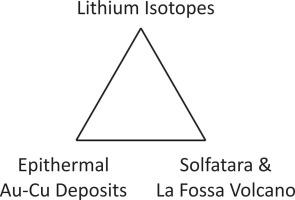Ore Geology Reviews ( IF 3.2 ) Pub Date : 2020-12-24 , DOI: 10.1016/j.oregeorev.2020.103934 Olivier Nadeau , Emily Mick , Philippe Robidoux , Fausto Grassa , Lorenzo Brusca , Alexandre Voinot , Matthew I. Leybourne

|
Hydrothermally-altered rocks collected at Solfatara volcano, Campi Flegrei caldera complex, Italy, are comparable to zones of steam-heated alterations found at low sulfidation epithermal deposits, and volcanic gases collected at Solfatara have temperatures and C-O-H isotopic compositions akin to those forming low sulfidation epithermal deposits. By contrast, hydrothermal alterations collected at La Fossa volcano, Vulcano island, Italy, are comparable to zones of residual vuggy silica formed in high sulfidation epithermal deposits, and volcanic gases collected at La Fossa have temperatures and C-O-H isotopic compositions comparable to those forming high sulfidation epithermal deposits. At Solfatara, amorphous and hydrous opal-A is responsible for shifts in δ7Li values, from +2.2‰ in fresher rocks, to −3.6‰ in most altered rocks, with increases in Au and Cu concentrations (up to 3 ppb and 96 ppm). The increase in Au and Cu concentrations in progressively-altered rocks resulted from the transport of Cu-Au in magmatic-hydrothermal fluids and their partitioning into pyrite, Fe oxides, phyllosilicates, sulfates, and/or opal-A. It is proposed that the combination of opal-A, decreases in δ7Li values, and increases in Cu and Au concentrations represent an exploration vector for low sulfidation epithermal veins. At La Fossa, α-cristobalite is responsible for shifts in δ7Li values, ranging from −0.9‰ in least-altered rocks, to +4.7‰ in most altered rocks, with decreases in Au-Cu concentrations. The decrease in Au and Cu concentrations in progressively-altered rocks may have resulted from the metasomatism of pyrite and Fe oxides, the dissolution of clinopyroxene and opal, and the invasion of the samples by α-cristobalite. The combination of α-cristobalite, increases in δ7Li values, and decreases in Cu and Au concentrations are proposed as proxies for potential high sulfidation epithermal disseminations. Alternating phases of high eruptive activity and quiescent degassing at volcanoes generally, and at Solfatara and La Fossa specifically, suggest that the physicochemical conditions of individual subvolcanic hydrothermal systems should also be alternating, between conditions that are characteristic of low- and high sulfidation epithermal ore-forming environments, and that the related zones of silicification should be alternating between low δ7Li and high Cu-Au values dominated by opal-A, and higher δ7Li and lower Cu-Au values dominated by α-cristobalite.
中文翻译:

来自意大利武尔卡诺岛的Solfatara火山,Campi Flegrei火山口复合体和La Fossa火山的热液蚀变中的锂同位素和Cu-Au浓度:对超热成矿环境的见解
在意大利Campi Flegrei火山口复合体的Solfatara火山中收集的热液蚀变岩石可与低硫化超热矿床中发现的蒸汽加热蚀变带相媲美,并且在Solfatara收集的火山气体具有与低硫化物类似的温度和COH同位素组成超热沉积。相比之下,意大利伏尔卡诺岛拉福萨火山收集的热液蚀变可与高硫化超热沉积物中形成的残余松散二氧化硅区相媲美,而拉福萨收集的火山气体的温度和COH同位素组成可与高硫化形成的那些相媲美。超热沉积。在Solfatara,无定形和含水蛋白石-A负责δ轮班7Li值从较新的岩石中的+ 2.2‰到大多数蚀变的岩石中的-3.6‰,随着Au和Cu浓度的增加(高达3 ppb和96 ppm)。逐渐改变的岩石中金和铜浓度的增加是由于铜-金在岩浆热液中的迁移及其分配为黄铁矿,氧化铁,层状硅酸盐,硫酸盐和/或蛋白石-A所致。本发明提出,蛋白石-A的结合,在δ减小7个李值,并且在Cu和Au中浓度的增加表示为低硫化热液静脉探索向量。在拉窝,α方晶石是负责在δ轮班7Li值变化最小的岩石为-0.9‰,大多数蚀变的岩石为+ 4.7‰,Au-Cu浓度降低。黄铁矿和铜氧化物的交代作用,斜辉石和蛋白石的溶解以及样品被α-方英石侵入,可能导致逐渐改变的岩石中金和铜浓度的降低。α方英石的组合,增加δ 7Li值以及Cu和Au浓度的降低被提议为潜在的高硫化超热扩散的代理。一般而言,在火山中,特别是在Solfatara和La Fossa,火山具有高喷发活动和静态脱气的交替阶段,表明各个亚火山热液系统的理化条件也应在低硫化和高硫化超热矿石所特有的条件之间交替变化。形成的环境,而硅化的相关区域应该是低的δ之间交替7 Li和高铜金值由蛋白石-A为主,和更高的δ 7 Li和降低由α方石英主导铜金值。











































 京公网安备 11010802027423号
京公网安备 11010802027423号